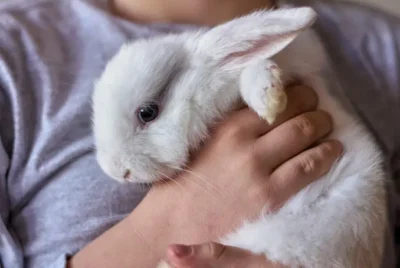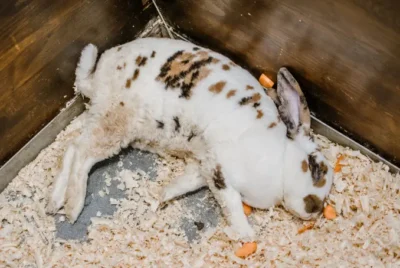Dewlaps on Rabbits: What Are They and Why Do They Exist
Dewlap on Rabbits’ tiny noses and fluffy tails make them one of nature’s cutest animals. But as any seasoned rabbit owner will tell you, these creatures are a bundle of intricacies. One such curiosity is the dewlaps—that fleshy, sometimes pendulous skin flap under a rabbit’s chin.
For many rabbit owners, especially newcomers, the dewlap raises several questions and concerns. Why does it exist? Is it a sign of a health issue? Or is it merely a part of certain breeds? Understanding the purpose and potential problems related to dewlaps is paramount for us as guardians of these delicate beings. Let’s delve into the world of rabbits and uncover the mystery behind these fascinating rabbit anatomical structures.
What Is a Dewlap?
A dewlap is a distinctive flap of skin and fatty tissue that hangs beneath the lower jaw or neck of certain animals, most notably seen in female rabbits. Dewlap in rabbits, particularly females, is a fat and fur reservoir for nesting material during pregnancy.
It’s normal for it to be different in size and prominence from one rabbit to the next, and things like the breed, age, and weight of the animal often play a role.
Characteristics of a Good Dewlap
A dewlap in rabbits is a distinct anatomical feature prominently located beneath the lower jaw or neck, primarily observed in rabbits. It varies in size, ranging from a subtle bump resembling a double chin to a more pronounced extension that can almost encircle the neck, giving it a pillow-like appearance.
Composed of skin and fatty tissue, the dewlap is more prevalent in mature female rabbits, particularly in larger breeds like Flemish Giants and lop-eared varieties. Though it’s a natural feature, its onset can sometimes lead pet owners to mistake it for a health concern.
Purpose of Dewlap on Rabbits
Dewlaps serve a pivotal role in the reproductive behaviors of rabbits, specifically female ones. This fatty and skin fold under the neck becomes a vital resource during the nesting phase. When a female rabbit, or doe, is preparing for the birth of her babies, she will pluck her own fur from the dewlap to line the nest. This action ensures the nest is soft, insulated, and conducive for the newborns. Rabbits have a dewlap to act as a natural reservoir of fur, making the nesting process more efficient and protective for the offspring.
Is It Possible for Male Rabbits to Have Dewlap?
Yes, male rabbits, or bucks, can indeed have dewlaps, although they are typically less pronounced than their female counterparts. A male rabbit’s dewlap is often a sign of higher estrogen levels.
This hormonal balance can result from neutering before the rabbit reaches puberty. Bucks’ dewlaps may indicate hormonal differences, especially in neutering, unlike does, but they are not linked to reproductive or nesting behaviors.
Is It a Concern If My Female Rabbit Lacks Dewlap?

The absence of a dewlap in a female rabbit is not inherently concerning. While many do develop dewlaps, not all will have pronounced ones, and some might not have them at all. Factors like breed, genetics, age, and whether unspayed female rabbits are unspayed can influence the development and prominence of a dewlap.
If a rabbit is healthy, active, and exhibits no signs of distress, the lack of a dewlap shouldn’t be a point of worry. However, it’s always good practice to consult with a veterinarian if there are any uncertainties about a rabbit’s health or anatomy.
At What Age Do Rabbits Start to Show Dewlap?
Female rabbits develop dewlaps during their transition to sexual maturity. For most rabbit breeds, this transitional phase occurs between four and six months of age. As the rabbit edges closer to this maturity milestone, the development and presence of the dewlap become more evident. The dewlap’s growth is a natural progression signaling the rabbit’s capability for reproduction, and its prominence can vary based on genetics and breed.
Can a Female Dewlap on Rabbits Vanish?
The dewlap in a female rabbit does not typically vanish entirely once it has developed. Dewlap, a characteristic of rabbits, can be diminished by hormonal changes after being spayed, affecting its size and prominence.
Additionally, significant weight loss or health issues could decrease dewlap size. While a dewlap might appear reduced in some situations, it doesn’t vanish entirely. Any drastic or sudden changes in a rabbit’s anatomy, including the dewlap, warrant consultation with a veterinarian to ensure the rabbit’s health and well-being.
How Can You Determine If Your Rabbit Is Normal or Obese?
Proportion to Body Size
- Normal: A rabbit with a dewlap proportional to its body size, mainly a prominent breed, may not be a cause for concern. For instance, larger breeds like Flemish Giants may naturally have more pronounced dewlaps.
- Obesity: If the dewlap seems excessively large compared to the rest of the rabbit’s body or is dragging and affecting their movement, it could be a sign of overweight rabbits.
Texture and Feel
- Normal: A typical dewlap will feel soft and fatty without any unusual lumps or irregularities.
- Obesity: An obese rabbit’s dewlap might feel unusually thick or dense when compared to a rabbit of a healthy weight. The dewlap may also spread out more than it hangs down.
Other Body Indicators
- Normal: A rabbit with a visible waist, a flat stomach, and ribs under a thin layer of flesh typically falls within a healthy weight range.
- Obesity: If the rabbit has rolls of fat, a sagging stomach, or its ribs are difficult to feel beneath thick layers of fat, it might be obese, so adjust the rabbit’s diet.
Mobility and Behavior
- Normal: Rabbits that move around freely, exhibit regular grooming habits, and can access all body parts without difficulty typically have a dewlap size that doesn’t interfere with their daily activities.
- Obesity: If a rabbit struggles to move, groom certain parts of its body, or seems lethargic, obesity could be a contributing factor.
The text explores the potential adverse effects of excessively loud dewlap on rabbits.
Overly pronounced dewlap in a rabbit can pose challenges for the animal. A particularly large dewlap may impede the rabbit’s ability to groom itself effectively, potentially leading to matting and accumulating debris in the fur. This could further result in skin irritations, fungal infections, and bacterial growth, accompanied by an unpleasant odor.
Additionally, excessive dewlap might interfere with the rabbit’s eating and drinking habits, causing wetness and matting around the area. To mitigate these issues, owners can assist with grooming and consider using a rodent water bottle instead of a bowl to reduce moisture around the dewlap. If the dewlap’s size continues to cause significant problems, consulting a veterinarian for potential solutions, including possible surgical reduction, might be necessary.
Dewlap on Rabbits’ Problems

Phantom Pregnancies
Female rabbits, whether spayed or not, might undergo a phenomenon called pseudopregnancy or phantom pregnancy. This entails the rabbit engaging in nesting behaviors even without the presence of a male rabbit.
Such behavior stems from hormonal changes associated with ovulation. During this period, the rabbit may pull fur from the dewlap and other body areas, leading to bald spots that expose her nipples.
Moist Dermatitis
When the rabbit’s dewlap stays wet and doesn’t dry, moist dermatitis, also known as “green fur syndrome,” causes painful skin. Older rabbits are particularly susceptible.
A wet hutch, bowl of drinking water, or leaking water bottle can cause a wet dewlap. Wet conditions combined with specific bacteria can even result in an abscess beneath the dewlap.
Moreover, dental diseases causing excessive drooling, termed ptyalism, can contribute to the issue. Extreme scratching, hair loss around the mouth and dewlap, dry, flaky skin, red or inflamed skin, a foul odor, and coat discoloration are symptoms. Early intervention by consulting a vet can prevent the escalation of these conditions.
How to Prevent Wet Dewlap On Rabbits
- Trim and brush the dewlap regularly.
- Opt for leak-free bottles over drinking bowls.
- Remove and replace wet or dirty bedding promptly.
- Provide unlimited hay and chew toys; monitor for dental issues.
- Help rabbits that struggle with self-grooming to keep the dewlap dry.
Flystrike
Flystrike occurs when flies lay eggs on a rabbit’s skin, which hatch into maggots that eat it. This often leads to severe infections. The rabbit dewlap and perineum are highly susceptible. Obesity, large dewlaps, urinary issues, old age, dental issues, and an inability to groom make rabbits more susceptible to flystrike.
Signs of flystrike encompass lethargy, reduced appetite, dehydration, and a noticeable stench. Immediate medical attention is crucial when spotting maggots. To thwart flystrikes, regular checks, especially during the warmer months, are essential.
Maintaining cleanliness by changing soiled bedding, feeding a proper diet, and ensuring a dry living environment are pivotal preventative measures.
Conclusion
Rabbit dewlaps are the extra skin and fat that you might see under the chin of mostly female rabbits. They’re not just there for looks! They have a job: to provide extra fur that momma rabbits can use to make a cozy nest for their babies.
However, not all dewlaps are the same. Some can be big, and some can be small. Rabbit owners need to keep an eye on them. So, a bunny’s dewlap is a natural and useful part of a rabbit’s body, but it also needs a little care to keep your bunny happy and healthy.




